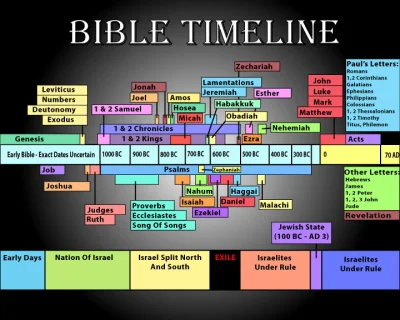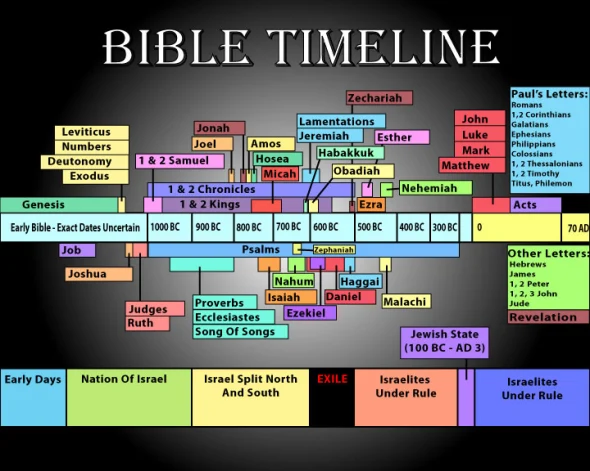How to read the Bible in chronological order
 Apart from flashbacks, it’s best to watch a video or read a story in chronological order from the beginning to the end. Did you know that some of the books of the Bible are not listed in chronological order? The message of the Bible was revealed progressively over a period of about 1,500 years. Some time ago I prepared a calendar to help read the whole Bible in one year, the “Bible in one year calendar”, which was based on the order of the books in our Bibles. Let’s look at the events described in the Bible in the sequence they occurred historically.
Apart from flashbacks, it’s best to watch a video or read a story in chronological order from the beginning to the end. Did you know that some of the books of the Bible are not listed in chronological order? The message of the Bible was revealed progressively over a period of about 1,500 years. Some time ago I prepared a calendar to help read the whole Bible in one year, the “Bible in one year calendar”, which was based on the order of the books in our Bibles. Let’s look at the events described in the Bible in the sequence they occurred historically.
Our Bibles
The books of most Bibles are arranged according to categories:
- Pentateuch (is also history) – Genesis to Deuteronomy
- History – Joshua to Esther
- Poetry – Job to Song of Songs
- Prophetic – Isaiah to Malachi
- Gospel – Matthew to John
- History – Acts
- Letters (Revelation is also prophetic) – Romans to Revelation
As the poets, prophets and letter writers wrote at particular times in history, the events they relate to may be recorded elsewhere in the Bible. A chronological Bible moves these writings nearer to their place in the historical account.
When were they written?
The Old Testament took about 1,000 years to write (1400 BC to 400 BC), whereas the New Testament took about 50 years to write (50AD to 100 AD). The chronological order of the books of the Bible according to when they were written is given below. These estimated dates of writing are based on current scholarship and because of uncertainties, they are often rounded. They give a general indication of when each book was written; it’s impossible to be more precise. Of course some books may have been written over a period of several years.
Biblical events in historical order
The Biblical writers describe events both before and after they occurred historically. Sometimes an event is predicted (like in the prophets) and sometimes an event is described afterwards or the record may be edited some time afterwards.
Three approaches have been used in chronological Bibles to place the recorded events in the order they actually occurred. These are based on the size of the portion of Scripture that is moved:
- “Whole books”, which has the advantage of preserving the context of the writings within each book. This is the simplest approach.
- “Whole chapters”, which enables the chapters to be placed more accurately in time order. For example, Job is within Genesis, individual psalms are placed within historical books, events in the gospels are cross-referenced and Paul’s letters are integrated within Acts.
- “Subdivided chapters”, which enables portions within chapters to be placed more accurately in time order. This is the most complex approach. For example see the “One year Chronological Bible” by Tyndale House Publishers. “Cover to cover complete” (CWR, 2012) is a more complicated version, which is based on “The Reese Chronological Bible” (1977).
A chronological Bible reading calendar
I have edited my “Bible in one year calendar” by placing the books in chronological order according to the events they describe. It is based on “whole books”, except the book of Job is placed between Genesis 12 and 13. This enables you to read the events in the general order they occurred historically. As this is based on current scholarship, the order differs slightly from the other chronological Bibles available on the internet. Another difference is that two passages are given each day, one from the Old Testament and one from the New Testament–Otherwise you would only be reading from the Old Testament for at least 70% of the year.
This enables the prophetic books to be read in historical order. The main distinction between these is: those written before the Babylonian exile; those written during the Babylonian exile; and those written after the Babylonian exile.
Written, January 2014

Bible Timeline image – 720 pixels.
(Drawn by MJ of Scotland, UK, 2009)
Written, January 2014
Also see: A new Bible timeline






This article helps me understand better the course of events in the Bible. It helps to be able to put an understandable date to some of these biblical events. I think it’s important to understand the context of the events in the Bible so as to gain new insights about Christianity.
LikeLike
March 1, 2017 at 6:49 am
I love it, I love it, I love it. This has been very informative.
LikeLike
February 10, 2018 at 2:14 am
George, this is a fantastic piece of work. Exactly what I am looking for. God bless you!
LikeLike
March 20, 2018 at 12:17 am
Is there some way I can get a good copy of the chart of the arrangment of the chronological order of reading the Bible in color as in on the internet on how to read the Bible in chronological order?
Mervin S. Horst
LikeLike
April 22, 2018 at 7:38 pm
Thanks Mervin, I will email my reply.
I have posted a larger copy of the Biblical Timeline at the end of this post. But if this 720 pixel image was created from the 400 pixel one at the top of the post, then the resolution will not be as good. Unfortunately, I don’t know where I sourced the original image from.
LikeLike
April 23, 2018 at 5:20 am
Hey! Thank you for this work! And I want to ask – why book of Joel doesn’t go before book of Jonah in Bible reading plan?
And another point – maybe I’m wrong but i cannot find Malachi book in the Bible reading plan.
God bless you!
LikeLike
November 2, 2018 at 12:16 am
Thanks for the comment Viktorija.
In my post I gave the estimated dates for writing of Jonah as ~750BC and Joel as ~700BC. That’s why Jonah is before Joel in the in the Bible reading plan.
Jonah prophesised during the reign of Jeroboam II (793-753)BC. But the book of Joel is difficult to date. The Jews have traditionally taken the view that Joel is a work of early composition. This is reflected by its position in the cannon between Hosea (written ~720BC) and Amos (written ~750BC). But modern scholars think it’s post-exilic (after 586BC).
The reason that Malachi isn’t shown on the Bible reading plan is because it’s on 31 December. The reading for this day is Malachi 1-4 (the last book of the Old Testament) and Revelation 22 (the last chapter of the New Testament). As this date is not specifically included in the table, we read the remainder of the Old and New Testaments on this day.
LikeLike
December 14, 2018 at 8:08 pm
Pingback: Observations in Genesis – Part 1 | Reasoned Cases for Christ
How can I get a poster with the Bible books in Chronological order like you have here on Pinterest? It’s one of the best I’ve seen to teach my kids.
LikeLike
November 30, 2019 at 12:16 am
Thanks Melissa, I have posted a larger copy of the Biblical Timeline at the end of this post. But if this 720 pixel image was created from the 400 pixel one at the top of the post, then the resolution will not be as good. Unfortunately, I don’t know where I sourced the original image from.
LikeLike
November 30, 2019 at 5:18 am
Thank you for sharing this. It helps clarify OT events in my mind. Most helpful and very appreciated.
LikeLike
December 15, 2021 at 11:40 am